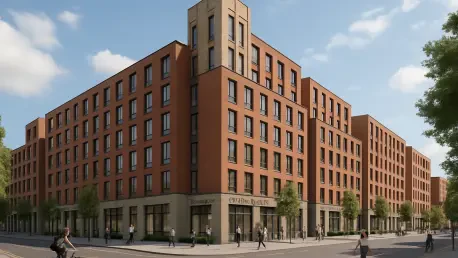In the dynamic landscape of London’s real estate market, Tottenham High Road stands as a focal point of transformation, driven by a pressing need for student housing amid rapid urban regeneration. With London hosting over 400,000 students annually and facing a persistent shortage of purpose-built student accommodation (PBSA), developers are under increasing pressure to deliver innovative solutions that balance capacity with community impact. This analysis delves into a landmark project led by McAleer & Rushe, a 287-bedroom development named The Printworks, which encapsulates broader market trends in PBSA and urban renewal. By examining the intersection of heritage preservation, sustainability demands, and growing student populations, this report uncovers critical insights into how such projects are shaping the capital’s property sector. The significance lies not just in meeting immediate housing needs but in redefining how historic districts adapt to modern challenges, offering a blueprint for stakeholders across the industry.
Dissecting Market Trends in Student Housing and Urban Development
Surge in Demand for Purpose-Built Student Accommodation
London’s status as a global education hub continues to fuel an unprecedented demand for student housing, with enrollment numbers climbing steadily and supply struggling to keep pace. Industry data suggests that the capital requires an additional 50,000 student beds over the next decade to address current shortfalls, particularly in areas like north London where affordability and proximity to universities are key concerns. Projects like the one on Tottenham High Road highlight a shift toward PBSA as a preferred solution over traditional shared housing, driven by students’ growing expectations for modern amenities, security, and community spaces. This trend is further amplified by international student inflows, which account for nearly 40% of the city’s university population, creating a lucrative yet competitive market for developers.
Regeneration as a Catalyst for Investment
Urban regeneration initiatives are increasingly intertwined with student housing developments, as seen in Tottenham, where historic corridors are being revitalized through strategic investments. Local authorities and private entities, including those tied to prominent sports organizations, are leveraging such projects to stimulate economic growth, improve infrastructure, and enhance public spaces. The integration of 287 new student bedrooms in this area not only addresses housing gaps but also injects vitality into a once-neglected high street, attracting ancillary businesses like cafes and retail outlets. Market forecasts indicate that regeneration-linked PBSA projects could see a 15% rise in investment over the next five years, from 2025 to 2030, as stakeholders recognize the dual benefits of social impact and financial returns.
Sustainability and Heritage as Market Differentiators
A notable evolution in the PBSA sector is the emphasis on sustainability and heritage conservation as competitive advantages. Developers are adopting energy-efficient designs and low-carbon materials to align with London’s stringent environmental targets, while also preserving historic facades to maintain cultural identity—a balance evident in the refurbishment of listed buildings along Tottenham High Road. This dual focus responds to consumer and regulatory pressures, with over 60% of students surveyed in recent studies prioritizing eco-friendly living spaces. However, incorporating these elements often increases upfront costs by 10-20%, posing challenges for scalability. Despite this, the long-term value of sustainable and heritage-sensitive projects is undeniable, positioning them as benchmarks in a crowded market.
Projecting Future Growth and Challenges in the Sector
Technological Innovations Shaping Construction
Looking ahead, technological advancements are poised to redefine the PBSA landscape, offering solutions to cost and efficiency hurdles. Modular construction techniques, which reduce build times by up to 30%, are gaining traction among developers aiming to meet tight urban deadlines without sacrificing quality. Additionally, smart building systems that optimize energy use and enhance resident experiences are becoming standard in new developments. As these innovations scale, industry analysts predict a potential 25% reduction in construction expenses by the end of the decade, making projects in high-demand areas like Tottenham more financially viable. Yet, adoption remains uneven, with smaller firms lagging due to capital constraints, signaling a need for broader policy support.
Policy and Community Dynamics in Urban Planning
The future of student housing also hinges on evolving urban policies and community engagement models. Local councils are increasingly mandating mixed-use developments that integrate student accommodations with public amenities, aiming to mitigate concerns over gentrification and transient populations. In Tottenham, the inclusion of communal and landscaped spaces reflects this trend, fostering connections between students and residents. However, tensions persist, as rising property values in regenerated zones risk displacing long-term locals. Market projections suggest that successful PBSA projects will depend on collaborative frameworks between developers, authorities, and communities to ensure equitable growth—a model that could see widespread adoption by 2030 if current pilots prove effective.
Expanding Market Opportunities Beyond London
While London remains the epicenter of PBSA demand, emerging opportunities in other UK cities are reshaping investment strategies. Regions with growing university populations, such as Manchester and Bristol, are witnessing a 12% annual increase in student housing projects, driven by lower land costs and supportive local policies. This diversification could alleviate pressure on the capital’s market, though it raises questions about oversaturation in secondary markets. For developers like those behind the Tottenham initiative, expanding portfolios to include regional projects offers a hedge against London’s volatile land prices, with expected returns stabilizing at 8-10% annually through 2030. This trend underscores a broader shift toward a national approach to student housing solutions.
Reflecting on Strategic Pathways Forward
Looking back, the detailed examination of Tottenham High Road’s transformation through McAleer & Rushe’s project reveals critical market dynamics that shape the student housing sector. The analysis highlights how escalating demand, regeneration efforts, and sustainability imperatives converge to create a new standard for urban development. It also uncovers the pivotal role of technology and policy in addressing cost and community challenges, setting a precedent for future initiatives. Moving forward, stakeholders are encouraged to prioritize adaptive reuse and green building practices while fostering partnerships with local entities to balance growth with inclusivity. A key recommendation is to invest in scalable technologies like modular construction to streamline costs without compromising quality. Additionally, exploring regional markets offers a strategic avenue to diversify risk and tap into untapped demand, ensuring that the lessons from Tottenham’s regeneration echo across the UK’s evolving property landscape.









